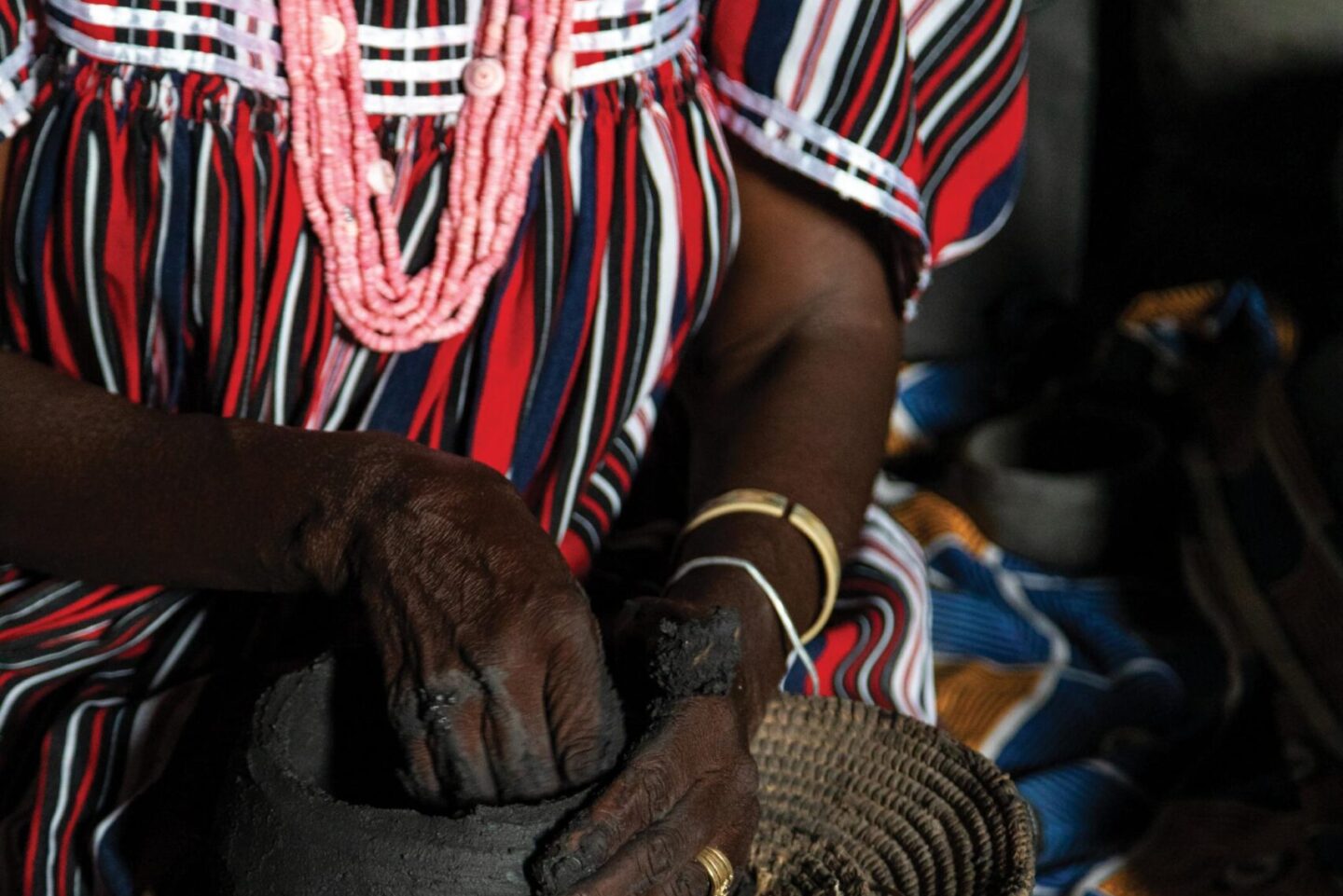

POTTERY - AN EPITOME OF AAWAMBO CRAFTSMANSHIP
The Aawambo people, a Bantu ethnic group, have been known for their craftsmanship for centuries. From forging iron products and weaving baskets to making pots, drums, bowls and other earthenware from a special type of clay.
Text Marx Itamalo | Photographs Marx Itamalo
From the Summer 2023/24 issue
Ihad the rare opportunity to visit one of the few Aawambo potters who are still dedicated to the art of pottery. In her traditional basement workshop, known as ondjibololo in the Oshikwanyama dialect, she produces clay pots (eembiya), bowls (omatiti) and drums (iitoo).
Ndahafa Nghishiiko is 78 years old. She lives in the village of Okadiva in the Ohangwena Region. Okadiva is about three kilometres from the Angolan border. Nghishiiko is an Omukwanyama and some of her kin live just across the border. Namibian Ovakwanyama and those living in Angola share very strong kinship ties.
As a girl growing up in her rural village, Nghishiiko learnt the pottery trade from her mother. Back then, you would find an ondjibololo behind almost every second homestead, she recalls. There were many of them and potters were many, too. Nghishiiko was kind enough to tell us more about the Aawambo pottery process and the significance of pottery in Aawambo tradition and culture.
Aawambo people have been producing earthenware for centuries. Earthenware was an integral part of their lives. Everything a household needed for handling food and water was made from clay: pots large and small, bowls in various shapes for serving meat or milk, plates, basins and even water drums or containers. Pipes for smoking were made from clay, too. People relied on items made from clay and making them was entirely entrusted to women.
THE PROCESS
Special clay is used for pottery. It is collected from a pit and taken to an ondjibololo, the basement workshop. This clay is not an ordinary one. It is a rare type, found only near anthills. In the ondjibololo it is mixed with a little water and left to rest overnight. The next morning it is taken out to dry in the sun the whole day. After drying, it is mixed with water once again and left to rest, but this time in the ondjibololo.
The potter or potters will then start molding the shapes of the items they want to create. An ondjibololo is constructed according to the number of people who will be working in it. Typically, an ondjibololo could accommodate between two to five people. It is like a trench fortified with four or more pillars and many poles laid flat on top. Branches of trees or blankets are also added. Soil is applied to them provide complete cover against the elements.
Inside, a potter can mold as many items as they want at the same time, provided there is enough clay. Creating a clay product can take up to a week from start to finish. The whole process takes place inside the ondjibololo and no product can be taken outside before it is finished, because it would crack if it is exposed to wind.
When work on the items is finished, by which time they are black in colour, they are put in a shallow pit filled with cattle dung. The pit is lit and the items are fired overnight to make them strong and give them their red colour. After firing the items are considered ready for use. For a touch of stylishness they can be stained bright red with a local onion-like plant called onzingankelo.
THE SIGNIFICANCE OF POTTERY PRODUCTS IN THE AAWAMBO CULTURE
BOWL (ETITI)
The traditional etiti bowl is held in high regard by the Aawambo people. It is used for serving all kinds of meat. The head of an Oshiwambo household should eat meat from an etiti. When visitors are served, meat should definitely be in the etiti. Whoever does not own one, male or female, is considered a disgrace and a coward.
FLAT BOWL (OLWIYO)
Another type of bowl common in the Aawambo culture is the olwiyo. This one is generally used for serving milk, beans and simple meals. Owning one is also mandatory. Children are mostly assigned an olwiyo for their daily use.
DRUM/BUCKET (OSHITOO)
The oshitoo is a large round kind of drum. It has many uses: Carrying water or traditional beer, and also to store water used for brewing the beer. The drums are essential items at traditional weddings and gatherings or festivals.
Each homestead ought to have them. Beer should not be carried in plastic or metal containers but only in these drums. When a woman dies, her relatives inherit her drums.
POT (OMBIYA)
Earthenware pots were traditionally used for cooking porridge or meat or for brewing beer. Today they are less common because clay pots need more firewood to heat. However, they are still found in Aawambo households which keep the traditions alive.
According to Nghishiiko it is Aawambo tradition that each homeowner must have an ombiya. “When a homeowner, man or woman, dies, the head and the left front hoof of every animal slaughtered for his or her mourning has to be cooked in that traditional pot – unskinned. Not this thing of today where you skin the head and hooves and you cook in metal pots. It was not like that in the past”.
Nghishiiko expects that the craft of pottery will soon die a natural death in the Aawambo community, as many of her generation are about to complete their earthly journeys. “The young people do not want to emulate us. They say we are old-school and that their generation has got nothing to do with clay items. I have a daughter and even she is not interested.”
Nonetheless, Nghishiiko says, she produces many clay items. Some of them are bought for weddings, baptisms and birthday parties. “People come here and I sell to them. Others refer me to their friends, colleagues and relatives. This is my craft and I will continue with it until my eyes and legs tell me they no longer can. Right now, I am ok and I will continue.” As our team leaves Nghishiiko’s ondjibololo, I cannot help but think of how magnificent it is that this old lady is not distracted by the kind of civilisation that has engulfed all the layers of Aawambo society. TNN






